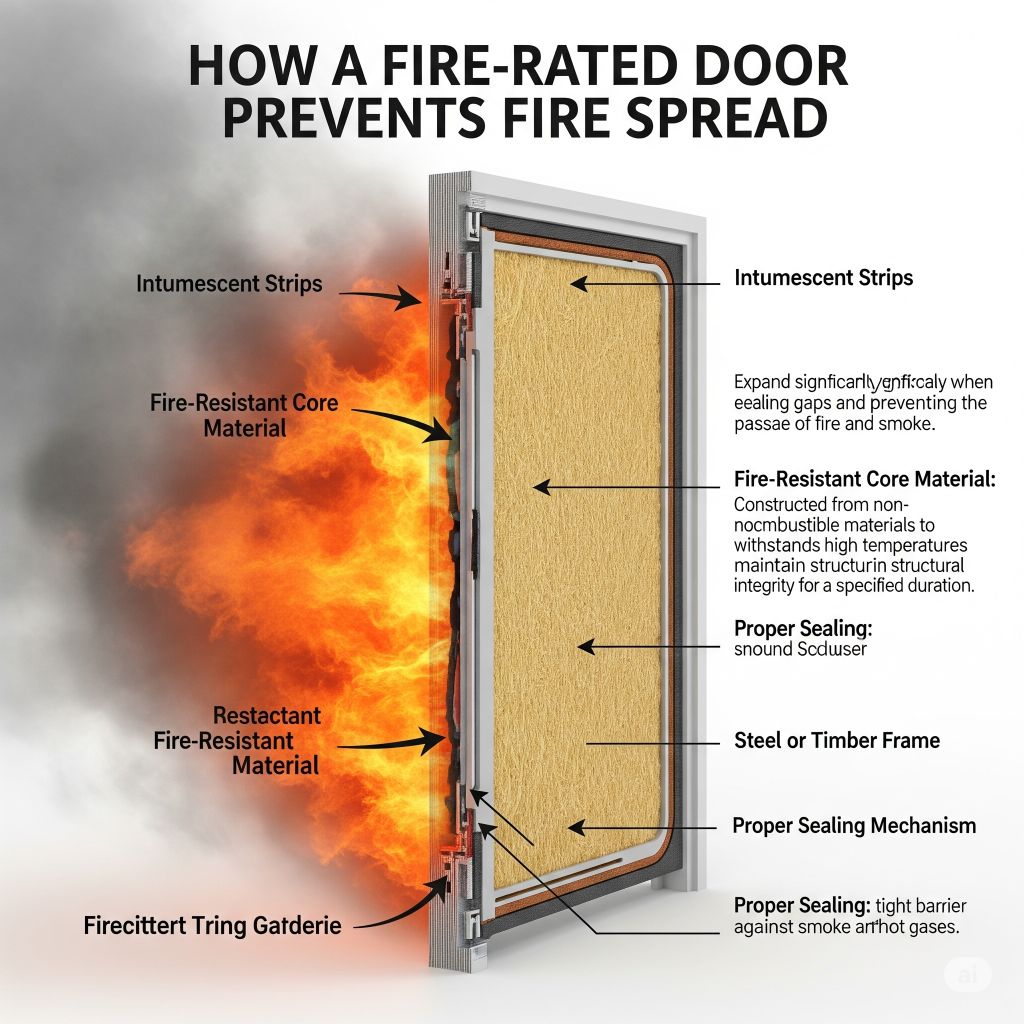
As a firefighter, I’ve seen firsthand the devastating effects of fires. One common question that comes up is whether a door can stop a fire. In this article, I’ll provide expert insights on this crucial topic.
When it comes to fire safety, understanding the role of doors is essential. Doors can be a critical barrier that slows down the spread of fire, giving occupants valuable time to escape. However, there are important factors to consider, such as the type of door and its fire rating.
Join me as I delve into the science behind fire behavior and the effectiveness of doors in containing fires. By the end of this article, you’ll have a better grasp of how doors can impact fire safety in various settings.
Key Takeaways
- Doors play a critical role in fire safety by slowing down the spread of fire and smoke, providing time for evacuation.
- Properly installed fire-rated doors are designed to withstand fire exposure for a specified time, aiding in safe evacuations.
- Factors affecting a door’s ability to stop a fire include material, installation, maintenance, seals, self-closing mechanism, and fire rating.
- Understanding fire behavior is essential for effective fire safety measures, with closed doors acting as vital barriers in containing fires.
- Different door types and fire ratings impact fire resistance, with steel doors offering excellent protection and regular maintenance being crucial for door effectiveness.
The Importance of Doors in Fire Safety
When it comes to fire safety, doors play a critical role in containing fires and protecting occupants. A properly installed and well-maintained door can significantly slow down the spread of fire and smoke, providing valuable time for evacuation.
Fire-rated doors are designed to withstand fire exposure for a specified amount of time, giving occupants a better chance of escaping safely. It’s essential to verify the fire rating of doors in different areas of a building to ensure they meet the required standards.
In the event of a fire, closed doors can act as barriers, preventing the rapid spread of flames and smoke from one area to another. This compartmentalization is crucial in limiting the damage caused by fires and protecting escape routes.
Properly functioning doors, along with adequate fire detection and suppression systems, are key components of a comprehensive fire safety plan. Regular inspections and maintenance of doors are necessary to ensure they remain effective in case of a fire emergency.
How Doors Can Slow Down Fire Spread
Doors are crucial components in fire safety measures. By being properly installed and maintained, doors play a significant role in slowing down the spread of fire and smoke in a building. Fire-rated doors, specifically designed to withstand fire exposure for a specified period, are particularly effective in this regard.
As a firefighter, I have witnessed firsthand how closed doors can act as vital barriers, preventing flames and smoke from rapidly moving to other areas. In the event of a fire, closed doors aid in compartmentalization, limiting the extent of fire damage and protecting essential escape routes for occupants.
It is important to understand that doors alone cannot contain a fire entirely, but they can certainly buy valuable time for individuals to evacuate safely. Through compartmentalization, properly closed doors can help delay the spread of fire and smoke, facilitating a safer evacuation process.
Regular inspections and maintenance of doors are imperative to ensure their efficacy in fire safety. Combined with fire detection and suppression systems, well-maintained doors significantly contribute to a comprehensive fire safety plan for any building.
Remember, in the event of a fire, closed doors can be a simple yet effective measure to slow down the spread of flames and smoke, ultimately enhancing the safety of building occupants.
Factors Affecting the Ability of a Door to Stop a Fire
When it comes to fire safety, the effectiveness of a door in stopping a fire depends on various factors. Here are some key considerations that impact a door’s ability to act as a barrier against fire and smoke:
- Material: The material of the door plays a crucial role. Fire-rated doors, constructed with materials that resist fire exposure, are specifically designed to withstand high temperatures and prevent the spread of flames.
- Installation: Proper installation is essential for a door to function effectively in a fire emergency. Doors must be installed according to manufacturer guidelines to ensure a tight fit and minimize gaps that could allow smoke and flames to pass through.
- Maintenance: Regular maintenance is key to ensuring that a door maintains its integrity over time. Damaged seals, hinges, or other components can compromise the fire resistance of a door, making it less effective in containing a fire.
- Seals and Gaps: Seals around the door frame and along the bottom are critical in preventing the passage of smoke and heat. Ensuring that these seals are intact and that there are no significant gaps around the door is essential for optimal fire protection.
- Self-Closing Mechanism: Many fire doors are equipped with a self-closing mechanism to ensure that the door automatically closes after being opened. This feature helps maintain the integrity of the fire barrier and prevents the spread of fire and smoke.
- Rating: The fire rating of a door indicates the duration for which it can withstand exposure to fire. Doors with higher fire ratings provide increased protection and are better equipped to delay the advance of a fire.
By considering these factors and ensuring that doors are properly maintained and installed, we can enhance the ability of doors to act as effective barriers against the spread of fire and smoke in a building.
Understanding Fire Behavior and Doors
When it comes to fire safety, understanding fire behavior is crucial. Fires spread rapidly, fueled by combustible materials, oxygen, and heat. As a firefighter, I have witnessed firsthand how fires move through a building, seeking out available fuel sources. It’s essential to recognize that doors play a vital role in containing fire and limiting its progression.
Fire doors are designed to withstand high temperatures and prevent the spread of flames and smoke from one area to another. In a fire emergency, closed doors can compartmentalize the fire, slowing its spread and providing valuable time for evacuation. Properly installed fire-rated doors, equipped with intact seals and self-closing mechanisms, are effective barriers against the advancement of fire and smoke.
As a firefighter, I have seen the difference that a well-maintained and properly installed door can make in containing a fire. Regular inspections and maintenance of doors are essential to ensure their effectiveness in an emergency. By understanding fire behavior and the role of doors in containment, we can enhance fire safety measures in buildings and protect lives.
Fire safety is a collaborative effort, and every component, including doors, plays a crucial role in preventing the spread of fire and protecting occupants. Adhering to manufacturer guidelines during door installation, checking seals for integrity, and ensuring prompt repairs are all key steps in maintaining effective fire barriers.
By staying informed about fire behavior and the functionality of fire-rated doors, we can work towards creating safer environments and minimizing the impact of fires on lives and property.
| Fact | Data |
|---|---|
| Fire spreads rapidly | Fire moves fast |
| Fire-rated doors withstand heat | Effective barrier |
| Regular maintenance is crucial | Ensure effectiveness |
The Impact of Door Type and Fire Ratings
When it comes to fire safety, understanding the impact of door type and fire ratings is crucial. Fire-rated doors are specifically designed to resist fire and smoke penetration, providing valuable time for occupants to evacuate a building safely. Different door types have varying levels of fire resistance, with some engineered to withstand fire for longer periods than others.
Fire ratings indicate the duration of time that a door can effectively resist fire and smoke. For instance, doors may be rated to withstand fire for 20 minutes, 60 minutes, or even 90 minutes. It’s essential to choose the appropriate fire-rated door based on the building’s requirements and potential fire hazards.
In addition to fire ratings, the material of the door also plays a significant role in its fire resistance. Steel doors, for example, offer excellent fire protection due to their high melting point and durability. On the other hand, wood doors may provide a certain degree of fire resistance but are more susceptible to heat and flames.
Proper installation is key to ensuring the effectiveness of fire-rated doors. Seals and self-closing mechanisms must be intact and functional to prevent the spread of fire and smoke. Regular maintenance is essential to address any wear and tear that could compromise the door’s fire resistance capabilities.
By understanding the impact of door type and fire ratings, fire safety measures can be optimized to enhance building occupants’ safety during emergencies. Choosing the right fire-rated door and adhering to installation and maintenance guidelines are essential steps in mitigating the risks associated with fires.
Conclusion
Understanding the importance of fire-rated doors and their role in fire safety is crucial. Fire behavior in relation to doors highlights the significance of selecting the right type with proper fire ratings. Materials like steel offer superior protection compared to wood. Installation, seals, and self-closing mechanisms play key roles in containing fire spread. Regular maintenance is essential to ensure doors maintain their fire resistance. By following guidelines and choosing the appropriate fire-rated door, building occupants’ safety can be greatly enhanced during emergencies.
Frequently Asked Questions
What is the importance of door behavior in fire safety?
Understanding fire behavior in relation to doors is crucial for fire safety. Fire-rated doors help contain and slow down fire progression, preventing the spread of fire and smoke.
How do fire-rated doors differ from regular doors?
Fire-rated doors are specifically designed to offer fire resistance, slowing down the spread of fire. They are made from materials like steel that provide better protection than wood.
What are key factors for fire-rated doors to be effective?
Proper installation, intact seals, and self-closing mechanisms are essential for fire-rated doors to effectively prevent fire and smoke spread.
Why is regular maintenance of fire-rated doors important?
Regular maintenance is necessary to uphold the doors’ fire resistance capabilities and ensure they function correctly during emergencies.
How can fire-rated doors improve building occupants’ safety during emergencies?
By selecting the appropriate fire-rated door, following installation and maintenance guidelines, building occupants’ safety during emergencies can be significantly improved.
